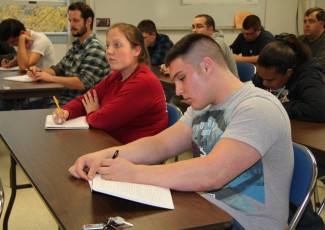N.C. Dual-Enrollment Program Expands
By Sonya Stinson
June 3, 2015
Sandhills Community College gets students ready for college and careers. The programs are more popular than ever, and new pathways are being added.
With a major assist from the public-schools superintendent, North Carolina’s Sandhills Community College has scored a record number of applicants for its dual-enrollment program, drawing from high school students in the county of the college’s main campus.
The dual-enrollment program is part of the statewide Career and College Promise initiative that launched in January 2012. In Moore County, more than 700 prospective high school juniors and seniors have applied to the program for fall 2015. That’s triple the number who signed up a year ago.
Rebecca Roush, vice president of academic affairs at Sandhills, believes the recent swell of Moore County applicants can be attributed, in part, to the enthusiastic advocacy of the Bob Grimesey, superintendent of Moore County Schools, who has encouraged the involvement of local principals and counselors.
“We can do all the things in the world, but until the principal and the counselors are fully behind it, frankly, it doesn’t matter what we do,” Roush says.
On the right track
The new uniform statewide program has supplanted the previous mix of dual-enrollment programs that existed throughout the state. For the first time, the program has also established two distinct academic tracks for the available courses: the college-transfer pathway and the career and technical pathway. College-transfer courses are available in four subject areas: humanities, social and behavioral sciences, math and engineering, and life sciences.
“Those were spelled out by the state, and then the individual colleges were given leave to develop career and technical pathways based on technical programs that they already had,” Roush says.
Starting with some of the college’s most popular existing programs, Sandhills administrators decided to develop diploma- or certificate-level pathways for high school students in cosmetology, automobile collision and repair technology, digital media technology, culinary arts and civil engineering technology. Roush says the initial setup was a bit of a scramble, with only a few months to prepare and a basic road map to follow.
“As we had some time to catch our breath, we looked at some other areas of interest,” Roush says.
In the fall of 2012, several more programs were added, including architectural technology, emergency medical services and hospitality management.
Moore County has three traditional high schools, while Hoke County, home to the college’s satellite campus, has two high schools — one traditional and one with an early-college model. Students in both counties can apply for dual enrollment. Roush notes that while the number of Moore County applicants has soared in the past year, the final fall 2015 enrollment is yet to be determined.
“Realistically, we won’t know what the increase is going to be — or if there is actually going to be an increase — until we start classes in the fall,” she says.
Replicating successful dual-enrollment programs
For other community college and public-school systems that might be interested in starting similar programs, Roush advises: “It’s very important to get all stakeholders on board. The faculty, for example, needs to be supported appropriately, so that it’s a positive experience for them and they’re not hesitant to have high school students in their classrooms.”
Another essential component: getting accurate information out to parents. Sandhills administrators have built strong relationships with district school counselors in high schools and middle schools, who often invite the college’s representatives to speak about the dual-enrollment program at parents’ nights.
Already, the program is showing some evidence of aiding college readiness. Roush estimates that about 25 percent of the students who enrolled in college courses at Sandhills while in high school go on to enroll as traditional students after high school graduation. Many of the remaining dual-enrollment participants go directly to a four-year college or university, she says.










